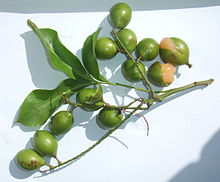- Melicoccus bijugatus
-
Melicoccus bijugatus 
Mamoncillo leaf and fruit Scientific classification Kingdom: Plantae (unranked): Angiosperms (unranked): Eudicots (unranked): Rosids Order: Sapindales Family: Sapindaceae Genus: Melicoccus Species: M. bijugatus Binomial name Melicoccus bijugatus
Jacq.Synonyms Melicoccus bijugatus, commonly called Spanish lime, genip, guinep, genipe, quenepa, mamoncillo, or honeyberry,[1] is a fruit-bearing tree in the soapberry family Sapindaceae, native or naturalised over a wide area of the tropics, including South and Central America, Mexico, the Caribbean, and parts of Africa and the Pacific.
Contents
Taxonomy
M. espritosantensis
M. pedicellaris
M. oliviformis
M. antioquensis
M. novogranatensis
M. aymardii
M. lepidopetalus
M. bijugatus
M. jimenezii
Phylogeny of Melicoccus based on morphological traits, showing the placement of M. bijugatus.[2] The genus Melicoccus was first described by Patrick Browne, an Irish doctor and botanist, in 1756. This description was based on M. bijugatus trees which were cultivated in Jamaica. In 1760, Nikolaus Joseph von Jacquin described the first species in Browne's genus, which he named M. bijugatus. In 1762 Linnaeus used a spelling variation of the name Melicocca bijuga. Over the next two centuries, Linnaeus' spelling variation was used in almost all publications. A proposal was made in 1994 to conserve Melicocca over Melicoccus, but the proposal was rejected, leading to a restoration of the original version of the name.[2]
In 1888 German taxonomist Ludwig Radlkofer placed Melicoccus in the tribe Melicocceae together with eight other genera. In his monograph on the Neotropical members of the tribe (Talisia and Melicoccus) Pedro Acevedo-Rodríguez suggested that although Talisia and Melicoccus appeared to form a monophyletic group, the other (Old World) genera probably did not belong to the same lineage.[2]
The specific epithet bijugatus refers to the bijugate leaves,[2] leaves which consist of two pairs of leaflets.
Local names
It is known as mamoncillo, mamón, and ackee (in St. Lucia, Barbados & Venezuela). However, in the rest of the Caribbean, the latter name is used to refer to the related Blighia sapida), and the fruit is called chenette (in Trinidad and Tobago), guaya, gnep, guinep (in Jamaica), guaya (in México), skinnip (in St. Kitts, Grenada), canepa, genip, guinep, ginnip, kenèp (in Dominica, Guyana, Antigua and Barbuda, Haiti, Belize, Bahamas) and in some parts of Central America, talpa jocote (in some parts of Guatemala), canepa, quenepa (in Puerto Rico), genepa, xenepa, kenepa (in Curaçao and Aruba), knippa (in Suriname) and Spanish lime and limoncillo (in the Dominican Republic).[citation needed] Also, it is often referred to as anoncillo in central Cuba and southern Florida.
Distribution
Melicoccus bijugatus is native to northern South America and naturalised in coastal and dry forest in Central America, the Caribbean and parts of the Old World tropics.[2] It is believed to have been introduced into the Caribbean in pre-Colombian times.[3]
Cultivation
Being tropical, M. bijugatus prefers warmer temperatures. Its leaves can be damaged if the temperature hits the freezing point, with serious damage occurring below -4°C.[citation needed]
It is grown and cultivated for its ovoid, green fruit, which grow in bunches.[2] The fruit, somewhat like a cross between a lychee and a lime, has a tight and thin, but rigid layer of skin, traditionally cracked by the teeth.[citation needed] Inside the skin is the tart, tangy, cream pulp (technically the seed coat), which is sucked by putting the whole fruit inside the mouth (the seed takes most of the volume of what is inside the skin).[citation needed] Despite the light color of the fruit's flesh, the juice stains a dark brown color, and was often used by indigenous Arawak natives to dye cloth.[citation needed]
The species is also commonly planted along roadsides as an ornamental tree.[2]
This fruit can be sweet or sour. In the southern areas of Mexico, it is generally eaten with chili powder, salt, and lime. The sweet varieties are generally eaten without condiments of any kind.[citation needed]
References
- ^ Bailey, L.H.; Bailey, E.Z.; the staff of the Liberty Hyde Bailey Hortorium. 1976. Hortus third: A concise dictionary of plants cultivated in the United States and Canada. Macmillan, New York.
- ^ a b c d e f g Acevedo-Rodríguez, Pedro (2003). "Melicocceae (Sapindaceae): Melicoccus and Talisia". Flora Neotropica 87: 1–178. JSTOR 4393917.
- ^ Francis, John K.. Melicoccus bijugatus Jacq. Quenepa. Sapindaceae. Soapberry family.. USDA Forest Service, Southern Forest Experiment Station, Institute of Tropical Forestry SO-ITF-SM; 48. http://www.fs.fed.us/global/iitf/pubs/sm_iitf048%20%20%284%29.pdf.
Categories:- Sapindaceae
- Tropical fruit
- Edible nuts and seeds
- Flora of northern South America
- Trees of Colombia
- Trees of Venezuela
- Trees of Guyana
Wikimedia Foundation. 2010.
